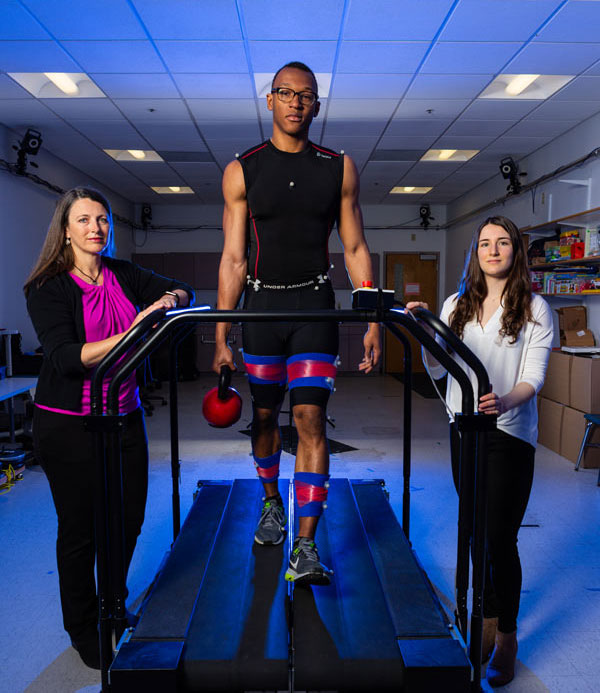Imagine a model walking down the catwalk, her skirt snapping with the dramatic lift and fall of her hips. While that walking pattern is an affectation of high fashion, a less exaggerated version is just as common off the runway.
When walking naturally, your hip abductor muscles fire, tipping your pelvis up and down. If the hip of your weight-bearing leg is weak, however, your opposite hip drops further to compensate, tilting your pelvis down at a steeper angle. That walking pattern, called pelvic drop, can cause inflammation, tendonitis, and other painful conditions in your hips and knees.
Everyone from athletes to octogenarians is susceptible to pelvic drop. Kerri Graber (’17,’19), a doctor of physical therapy student, has helped evaluate an exercise to prevent it. Along with her mentor, Cara Lewis, she found that a simple hand weight can have a big impact on hip muscles—and can be used both in the clinic and at home.

Graber was drawn to physical therapy when she was a member of the BU track team and needed physical therapy for minor injuries. “I wanted to learn more about how the body works, how it ages, and how it heals,” she says, “and to find ways to help people become more mobile and recover from injury faster.”
During her second year of Sargent’s six-year accelerated Doctor of Physical Therapy (DPT) program, Graber enrolled in a biomechanics course taught by Kenneth G. Holt, an associate professor emeritus. “It was super cool to quantify movements of the body and understand how movement at the hip, for example, can affect what’s happening at the foot,” she says. “That understanding of movement up and down the chain of the body is fascinating to me.”
For further study in biomechanics, Graber’s academic advisor connected her with Lewis, an associate professor of physical therapy, whose Human Adaptation Lab focuses on motor adaptation—how our bodies learn and modify movements—specific to reducing hip pain. Lewis is a pioneering advocate for rehabilitation as prevention, with work funded by the National Institutes of Health. Her lab was a natural fit for Graber, who’s been there ever since.
In her fifth year of the DPT program, Graber worked with Lewis to develop a practicum project to alleviate pelvic drop.
“Kerri had to do a lot to figure out that research project,” Lewis says. “How are we going to test it? What are the specifics of the protocol?”
“I couldn’t have asked for a better mentor,” Graber says. “Cara not only taught me how challenging it can be to put together a research project, but also how rewarding it can be; she guided me through the steps of designing a research project, from creating a clinical question all the way through data processing and drafting an abstract for submission to a conference.”
First, the researchers acquired baseline data, measuring their subjects’ muscle activation with electrodes placed on their skin while walking on a treadmill. Then, they measured the subjects’ muscle activation when they held a kettlebell, weighing 15 to 20 percent of their body weight, opposite the side with pelvic drop. Graber and Lewis found that those muscles activated more to counterbalance the weight and stabilize the pelvis.
“Across the board, we found significant increases in muscle activation when subjects were walking with the weight, compared to their baseline walking,” Graber says. As the researchers expected, the exercise did not increase muscle activation on both sides of the pelvis; “it just targeted the side we wanted.”
Graber presented the research at the 2019 Combined Sections Meeting of the American Physical Therapy Association, where her peers were excited by the exercise’s potential beyond the clinic. Graber’s next step is to figure out how the intervention can be done in the home.
“A big question is how to help patients who are elderly and have hip weakness, but can’t carry 15 to 20 percent of their body weight in their hand,” Graber says. “We need to determine the minimum amount of weight needed to increase muscle activation enough to strengthen the hip.”
She also intends to adapt the intervention so those with hip weakness can work on the exercises during their daily routines. One example: carrying grocery bags in the arm opposite the weak hip, Graber says. “Just functional ways to get those muscles activating more. You don’t need to carry around a 15-pound kettlebell; you could do this exercise on your walk home from the grocery store.”
